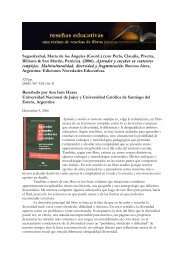Jefatura femenina de hogar, pobreza urbana y exclusión - CROP
Jefatura femenina de hogar, pobreza urbana y exclusión - CROP
Jefatura femenina de hogar, pobreza urbana y exclusión - CROP
You also want an ePaper? Increase the reach of your titles
YUMPU automatically turns print PDFs into web optimized ePapers that Google loves.
JEFATURA FEMENINA DE HOGAR, POBREZA URBANA Y EXCLUSIÓN SOCIAL<br />
dirigentes en correspon<strong>de</strong>ncia con las altas exigencia <strong>de</strong> tiempo y esfuerzos;<br />
prejuicios sobre la idoneidad <strong>de</strong> la dirección masculina; y las<br />
propias limitaciones <strong>de</strong> la mujer para asumir responsabilida<strong>de</strong>s a ese<br />
nivel, dadas sus responsabilida<strong>de</strong>s sociales y familiares (Díaz, 2004).<br />
En cuanto a la participación política, Cuba ocupa el primer lugar<br />
<strong>de</strong> los países <strong>de</strong> la región y séptimo en el mundo con mayor proporción<br />
<strong>de</strong> mujeres integrantes <strong>de</strong>l parlamento. En la actualidad, ellas constituyen<br />
el 36% <strong>de</strong>l mismo; existen 6 mujeres ministras y 33 viceministras<br />
–muchas en áreas no tradicionales para la mujer–, lo que representa un<br />
16,2% <strong>de</strong> cargos ministeriales <strong>de</strong>sempeñados por mujeres; su presencia<br />
se ha incrementado en sectores no tradicionales: 71% <strong>de</strong> los oficiales<br />
<strong>de</strong> justicia locales, 60,3% <strong>de</strong> los jueces profesionales, 47% <strong>de</strong> los jueces<br />
<strong>de</strong> la Corte Suprema y 60% <strong>de</strong> los ejecutivos <strong>de</strong>l sector judicial (CiEM,<br />
2003; PnuD, 2005).<br />
Por todo ello, según el Índice <strong>de</strong> Potenciación <strong>de</strong> Género, Cuba presenta<br />
una muy favorable situación y el Objetivo <strong>de</strong> Desarrollo <strong>de</strong>l Milenio relativo<br />
a la igualdad en la participación política se evalúa como <strong>de</strong> muy<br />
probable cumplimiento.<br />
100<br />
Cuadro 11<br />
Diputados a la Asamblea Nacional <strong>de</strong>l Po<strong>de</strong>r Popular electos<br />
Elecciones <strong>de</strong> 1993 Elecciones <strong>de</strong> 1998 Elecciones <strong>de</strong> 2003<br />
Diputados electos 589 601 609<br />
Mujeres (%) 22,75 27,62 35,96<br />
Fuente: CIEM (2003).<br />
Cuadro 12<br />
Índice <strong>de</strong> Desarrollo Humano (IDH), Índice <strong>de</strong> Desarrollo <strong>de</strong> Género (IDG) e<br />
Índice <strong>de</strong> Potenciación <strong>de</strong> la Mujer (IPG)*<br />
Año IDH Posición IDG Posición IPG Posición<br />
1995 0,769 72 0,726 47 0,524 16<br />
1996 0,726 79 0,699 59 0,522 21<br />
1997 0,723 86 0,699 68 0,523 23<br />
1998 0,729 85 0,705 69 0,523 25<br />
1999 0,765 58 0,762 53 0,556 21<br />
2000 0,783 56 – – – –






